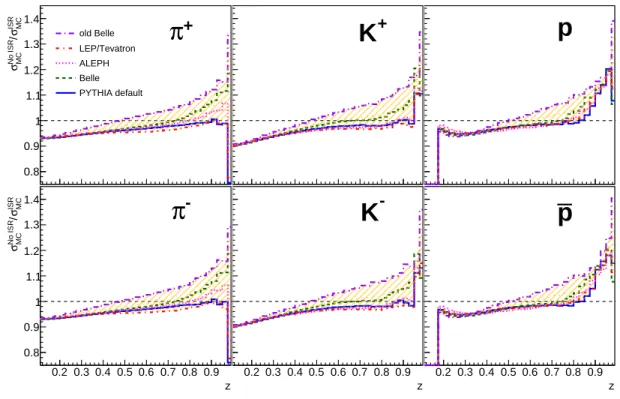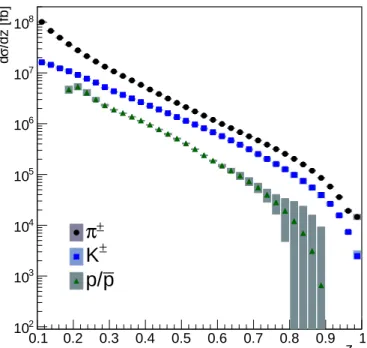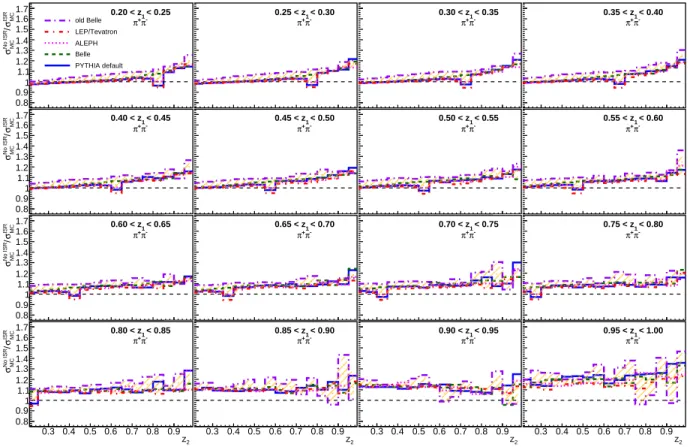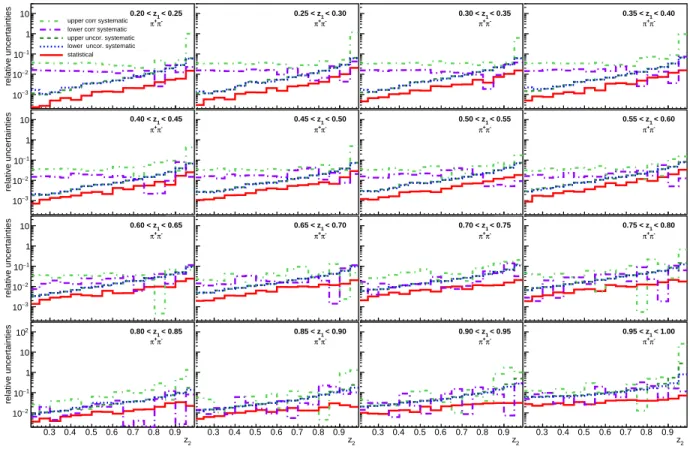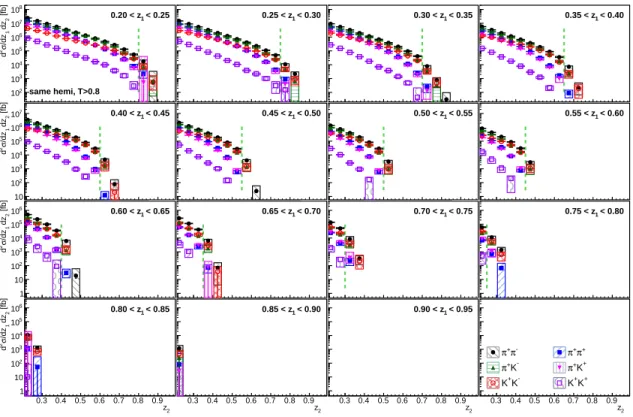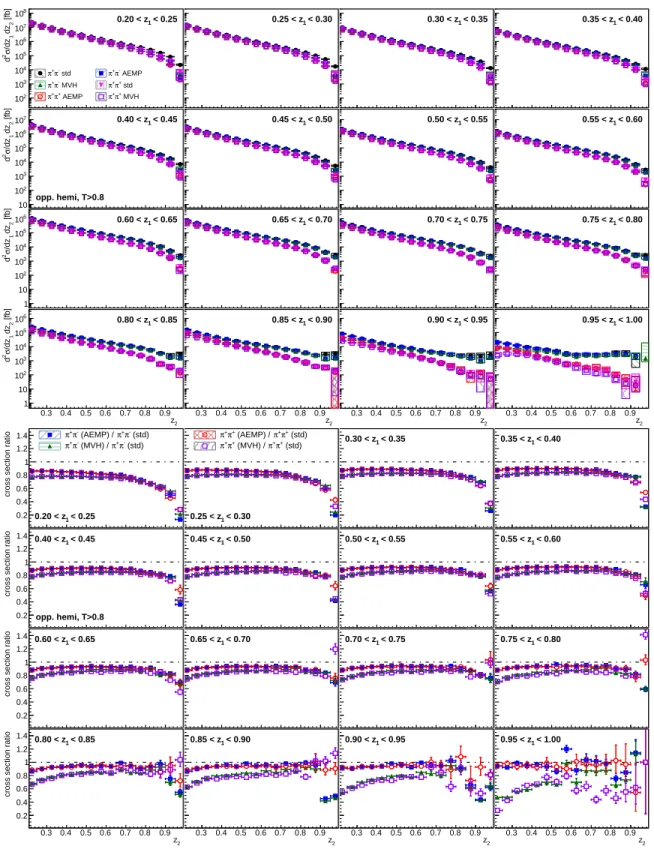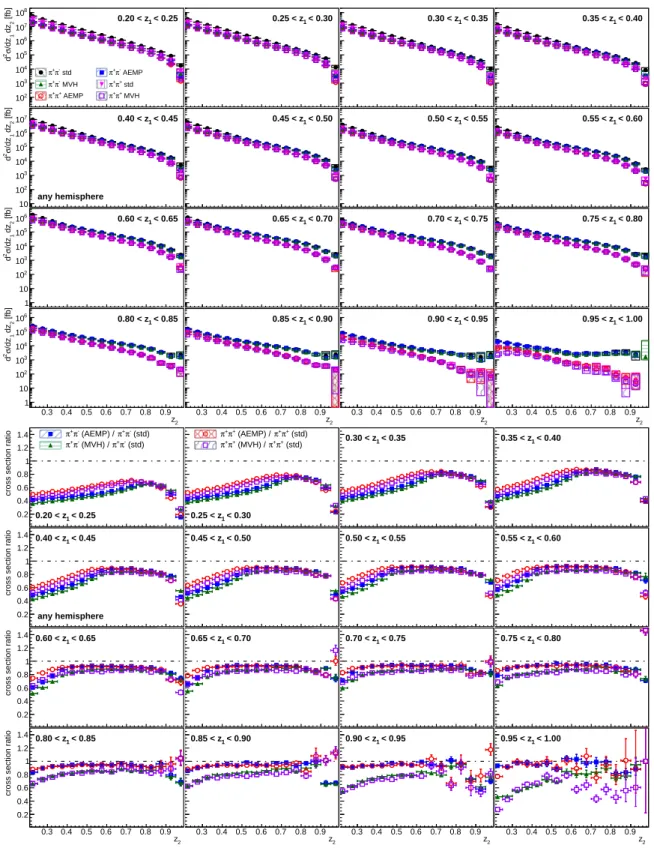hadrons
R. Seidl,63 I. Adachi,16, 13 H. Aihara,76 D. M. Asner,3 V. Aulchenko,4, 57 T. Aushev,48I. Badhrees,69, 33 P. Behera,23 K. Belous,27J. Bennett,45B. Bhuyan,21J. Biswal,31M. Braˇcko,42, 31 T. E. Browder,15M. Campajola,28, 50L. Cao,82 D. ˇCervenkov,5 M.-C. Chang,11V. Chekelian,43 A. Chen,52 K. Chilikin,38 K. Cho,34 Y. Choi,68 S. Choudhury,22 D. Cinabro,80 S. Cunliffe,8G. De Nardo,28, 50 F. Di Capua,28, 50 S. Eidelman,4, 57, 38 D. Epifanov,4, 57 J. E. Fast,59 T. Ferber,8B. G. Fulsom,59V. Gaur,79 A. Garmash,4, 57 A. Giri,22 P. Goldenzweig,32K. Hayasaka,56 H. Hayashii,51
W.-S. Hou,54 K. Huang,54 K. Inami,49 A. Ishikawa,16, 13 M. Iwasaki,58 Y. Iwasaki,16 W. W. Jacobs,24 S. Jia,2 Y. Jin,76 K. K. Joo,6 G. Karyan,8 D. Y. Kim,67 S. H. Kim,14 P. Kodyˇs,5 S. Korpar,42, 31 P. Kriˇzan,39, 31 R. Kroeger,45P. Krokovny,4, 57 A. Kuzmin,4, 57 Y.-J. Kwon,81 S. C. Lee,36 Y. B. Li,60 L. Li Gioi,43 J. Libby,23
C. MacQueen,44 M. Masuda,75 T. Matsuda,46 D. Matvienko,4, 57, 38 M. Merola,28, 50 K. Miyabayashi,51 R. Mizuk,38, 48 R. Mussa,29 M. Nakao,16, 13 M. Nayak,72 N. K. Nisar,61S. Nishida,16, 13 K. Nishimura,15 S. Ogawa,73
H. Ono,55, 56 P. Oskin,38 P. Pakhlov,38, 47 G. Pakhlova,38, 48 S. Pardi,28 S.-H. Park,81 S. Patra,20 S. Paul,71 T. K. Pedlar,41 L. E. Piilonen,79 T. Podobnik,39, 31 V. Popov,38, 48 E. Prencipe,18 M. T. Prim,32M. Ritter,40
N. Rout,23 G. Russo,50 D. Sahoo,70 Y. Sakai,16, 13 S. Sandilya,7 L. Santelj,16 T. Sanuki,74 V. Savinov,61 O. Schneider,37 G. Schnell,1, 19 C. Schwanda,26 Y. Seino,56 M. E. Sevior,44 M. Shapkin,27 V. Shebalin,15 J.-G. Shiu,54 B. Shwartz,4, 57 E. Solovieva,38 M. Stariˇc,31 Z. S. Stottler,79 M. Sumihama,12 T. Sumiyoshi,78 W. Sutcliffe,82 M. Takizawa,65, 17, 62 K. Tanida,30 F. Tenchini,8 M. Uchida,77T. Uglov,38, 48 Y. Unno,14 Y. Usov,4, 57
R. Van Tonder,82 G. Varner,15 V. Vorobyev,4, 57, 38A. Vossen,9 C. H. Wang,53 M.-Z. Wang,54 P. Wang,25 S. Watanuki,74E. Won,35 X. Xu,66 S. B. Yang,35 J. Yelton,10 Z. P. Zhang,64V. Zhilich,4, 57 and V. Zhukova38
(The Belle Collaboration)
1University of the Basque Country UPV/EHU, 48080 Bilbao
2Beihang University, Beijing 100191
3Brookhaven National Laboratory, Upton, New York 11973
4Budker Institute of Nuclear Physics SB RAS, Novosibirsk 630090
5Faculty of Mathematics and Physics, Charles University, 121 16 Prague
6Chonnam National University, Gwangju 61186
7University of Cincinnati, Cincinnati, Ohio 45221
8Deutsches Elektronen–Synchrotron, 22607 Hamburg
9Duke University, Durham, North Carolina 27708
10University of Florida, Gainesville, Florida 32611
11Department of Physics, Fu Jen Catholic University, Taipei 24205
12Gifu University, Gifu 501-1193
13SOKENDAI (The Graduate University for Advanced Studies), Hayama 240-0193
14Department of Physics and Institute of Natural Sciences, Hanyang University, Seoul 04763
15University of Hawaii, Honolulu, Hawaii 96822
16High Energy Accelerator Research Organization (KEK), Tsukuba 305-0801
17J-PARC Branch, KEK Theory Center, High Energy Accelerator Research Organization (KEK), Tsukuba 305-0801
18Forschungszentrum J¨ulich, 52425 J¨ulich
19IKERBASQUE, Basque Foundation for Science, 48013 Bilbao
20Indian Institute of Science Education and Research Mohali, SAS Nagar, 140306
21Indian Institute of Technology Guwahati, Assam 781039
22Indian Institute of Technology Hyderabad, Telangana 502285
23Indian Institute of Technology Madras, Chennai 600036
24Indiana University, Bloomington, Indiana 47408
25Institute of High Energy Physics, Chinese Academy of Sciences, Beijing 100049
26Institute of High Energy Physics, Vienna 1050
27Institute for High Energy Physics, Protvino 142281
28INFN - Sezione di Napoli, 80126 Napoli
29INFN - Sezione di Torino, 10125 Torino
30Advanced Science Research Center, Japan Atomic Energy Agency, Naka 319-1195
31J. Stefan Institute, 1000 Ljubljana
32Institut f¨ur Experimentelle Teilchenphysik, Karlsruher Institut f¨ur Technologie, 76131 Karlsruhe
33King Abdulaziz City for Science and Technology, Riyadh 11442
arXiv:2001.10194v2 [hep-ex] 30 Jan 2020
34Korea Institute of Science and Technology Information, Daejeon 34141
35Korea University, Seoul 02841
36Kyungpook National University, Daegu 41566
37Ecole Polytechnique F´´ ed´erale de Lausanne (EPFL), Lausanne 1015
38P.N. Lebedev Physical Institute of the Russian Academy of Sciences, Moscow 119991
39Faculty of Mathematics and Physics, University of Ljubljana, 1000 Ljubljana
40Ludwig Maximilians University, 80539 Munich
41Luther College, Decorah, Iowa 52101
42University of Maribor, 2000 Maribor
43Max-Planck-Institut f¨ur Physik, 80805 M¨unchen
44School of Physics, University of Melbourne, Victoria 3010
45University of Mississippi, University, Mississippi 38677
46University of Miyazaki, Miyazaki 889-2192
47Moscow Physical Engineering Institute, Moscow 115409
48Moscow Institute of Physics and Technology, Moscow Region 141700
49Graduate School of Science, Nagoya University, Nagoya 464-8602
50Universit`a di Napoli Federico II, 80055 Napoli
51Nara Women’s University, Nara 630-8506
52National Central University, Chung-li 32054
53National United University, Miao Li 36003
54Department of Physics, National Taiwan University, Taipei 10617
55Nippon Dental University, Niigata 951-8580
56Niigata University, Niigata 950-2181
57Novosibirsk State University, Novosibirsk 630090
58Osaka City University, Osaka 558-8585
59Pacific Northwest National Laboratory, Richland, Washington 99352
60Peking University, Beijing 100871
61University of Pittsburgh, Pittsburgh, Pennsylvania 15260
62Theoretical Research Division, Nishina Center, RIKEN, Saitama 351-0198
63RIKEN BNL Research Center, Upton, New York 11973
64University of Science and Technology of China, Hefei 230026
65Showa Pharmaceutical University, Tokyo 194-8543
66Soochow University, Suzhou 215006
67Soongsil University, Seoul 06978
68Sungkyunkwan University, Suwon 16419
69Department of Physics, Faculty of Science, University of Tabuk, Tabuk 71451
70Tata Institute of Fundamental Research, Mumbai 400005
71Department of Physics, Technische Universit¨at M¨unchen, 85748 Garching
72School of Physics and Astronomy, Tel Aviv University, Tel Aviv 69978
73Toho University, Funabashi 274-8510
74Department of Physics, Tohoku University, Sendai 980-8578
75Earthquake Research Institute, University of Tokyo, Tokyo 113-0032
76Department of Physics, University of Tokyo, Tokyo 113-0033
77Tokyo Institute of Technology, Tokyo 152-8550
78Tokyo Metropolitan University, Tokyo 192-0397
79Virginia Polytechnic Institute and State University, Blacksburg, Virginia 24061
80Wayne State University, Detroit, Michigan 48202
81Yonsei University, Seoul 03722
82University of Bonn, 53115 Bonn
We report new measurements of the production cross sections of pairs of charged pions and kaons as a function of their fractional energies using various fractional-energy definitions. Two different fractional-energy definitions were used and compared to the conventional fractional-energy definition reported previously. The new variables aim at either identifying dihadron cross sections in terms of single-hadron fragmentation functions, or to provide a means of characterizing the transverse momentum created in the fragmentation process. The results were obtained applying the updated initial-state radiation correction used in other recent Belle publications on light-hadron production cross sections. In addition, production cross sections of single charged pions, kaons, and protons were also updated using this initial-state radiation correction. The cross sections are obtained from a 558 fb−1 data sample collected at the Υ(4S) resonance with the Belle detector at the KEKB asymmetric-energye+e−collider.
The hadronization of highly energetic partons into final-state hadrons is often parameterized in terms of
fragmentation functions. They are nonperturbative ob- jects that at present cannot be calculated from first principles in the theory of the strong interaction, quan- tum chromodynamics (QCD). Factorization proofs, when applicable, allow one to extract fragmentation func- tions from experimental data of various high-energy pro- cesses [1], such as lepton-nucleon scattering, hadron- hadron collision, or electron-positron annihilation. In turn they can then be used to study in more detail the partonic flavor and spin structure of the nucleon. Frag- mentation functions are generally parameterized in terms of the initial parton flavor, detected hadron type, the en- ergy or momentum fraction the detected hadron carries relative to the initial parton, as well as variables sensitive to parton spin or transverse momentum relative to the parton momentum direction. The clean initial state of the electron-positron annihilation process serves as the ideal tool to study fragmentation although the sensitiv- ity to the parton flavor is limited. Detecting more than one hadron in the final state can partially overcome this limitation.
In the initial Belle publication [2], the dihadron cross sections in electron-positron annihilation,e+e− → h1h2X, were measured as a function of the fractional energies zi = 2Eh,i/√
s of the two hadrons in various topologies. Here, √
s is the center-of-mass (c.m.) en- ergy and Eh,i the c.m. energy of hadron i. Theorists brought to our attention two different fractional energy or momentum definitions: one that facilitates the inter- pretation of cross sections for pairs of nearly back-to- back hadrons in terms of single-hadron fragmentation functions [3], the other serves to highlight the transverse momentum produced in the fragmentation process [4].
Moreover, in these alternative definitions, no additional thrust or hemisphere requirements are explicitly neces- sary since their definitions take the selection of back- to-back hadrons originating from two different partons into account directly via scalar products between the two hadron four-momenta. This feature in turn allows the in- terpretation of the cross sections even at higher orders of the strong coupling, which might not be possible in the conventional definition. The first alternative definition is in fact the oldest definition overall, already suggested in Ref. [3]. The fractional energy of the first hadron is the same as the nominal definition, written in terms of four-vectors for hadronsPi and the virtual photonqas
z1=2P1·q
q2 , (1)
where q·q = s is the squared four-momentum of the virtual photon. The fractional-energy definition for the second hadron differs in that it includes scalar products of the two hadron four-momenta:
z2=u= P1·P2
P1·q . (2)
It thus has a maximal contribution where the two hadrons are back-to-back and small values when the
hadrons are found within the same hemisphere. This set of fractional momenta will be referred to as the AEMP [3] definition in the following.
The other alternative fractional-energy definition is in part similar to the AEMP definition, but puts more stress on the masses of the hadrons,Mh1/2, and is motived to assess the transverse-momentum dependence of single- hadron fragmentation functions in the two-hadron sys- tem:
z1=
P1·P2−Mh12 Mh22 P1·P2
1 P2·q−Mh22 PP1·q
1·P2
, (3)
and vice versa for z2 when interchanging the indices of the first and second hadron. This definition will be referred to as the Mulders-VanHulse, or MVH [4], definition throughout this publication.
Both fractional-energy definitions will be compared to the conventional definition. They are similar to the con- ventional definition in that they can be seen as the frac- tion of the initial parton energy that a hadron carries.
However, while the conventional and AEMP definitions are typical scaling variables limited to values between zero and one, the MVH fractional energy can exceed these limits, especially when the two hadrons are in the same hemisphere. For nearly back-to-back hadron pairs they are expected to behave similarly [4], however, the distri- butions are expected to be shifted to lowerzdue to the presence of non-zero transverse momentum.
In addition to reporting these three fractional-energy definitions, all cross section measurements in this pub- lication use an updated version of the initial-state radi- ation (ISR) correction. Unlike the previous publication [2] for the dihadron fractional-energy dependence, an ISR correction is used that enables the direct applicability in global fits. This updated ISR correction is also applied to the previously published [2, 5] single pion, kaon, and pro- ton cross sectionse+e− →hX as a function ofz, where the fractional energy is given by z = 2Eh/√
s. For the dihadron cross sections, also the ordering by hemisphere was removed, combining all hadron pair permutations of the same physics content, such asπ+π−andπ−π+. Fur- thermore, all systematic uncertainties are now separated into components that are correlated over kinematic bins and those that ar uncorrelated.
The paper is organized as follows: In Section I the up- dated correction procedure will be discussed and conse- quently applied to obtain the updated single-hadron cross sections. In Section II the same update is performed also for the dihadron cross sections together with the com- bination of permutations. In Section III the dihadron cross sections are compared to the new fractional-energy definitions before a summary concludes this publication.
z 0.2 0.3 0.4 0.5 0.6 0.7 0.8 0.9 ISR MCσ/No ISR MCσ
0.8 0.9 1 1.1 1.2 1.3
1.4
p
z 0.2 0.3 0.4 0.5 0.6 0.7 0.8 0.9 ISR MCσ/No ISR MCσ
0.8 0.9 1 1.1 1.2 1.3
1.4z
p
0.2 0.3 0.4 0.5 0.6 0.7 0.8 0.9 ISR MCσ/No ISR MCσ
0.8 0.9 1 1.1 1.2 1.3
1.4 +
K
z 0.2 0.3 0.4 0.5 0.6 0.7 0.8 0.9 ISR MCσ/No ISR MCσ
0.8 0.9 1 1.1 1.2 1.3
1.4 -
z
K
0.2 0.3 0.4 0.5 0.6 0.7 0.8 0.9 ISR MCσ/No ISR MCσ
0.8 0.9 1 1.1 1.2 1.3
1.4 old Belle
π
+LEP/Tevatron ALEPH Belle PYTHIA default
z 0.2 0.3 0.4 0.5 0.6 0.7 0.8 0.9 ISR MCσ/No ISR MCσ
0.8 0.9 1 1.1 1.2 1.3
1.4
π
-FIG. 1. Non-ISR over ISR cross section ratios as a function of z for pions, kaons, and protons for various MC tunes. The yellow, hatched regions display the variation of these ratios with tunes and are assigned as systematic uncertainties around the Belle tune.
I. UPDATE OF SINGLE-HADRON CROSS SECTION MEASUREMENTS
The analysis in this publication closely follows all steps mentioned in Ref. [2]. To recall that analysis, it is briefly described here. A total data set of 558 fb−1 collected with the Belle detector at the center-of-mass (c.m.) en- ergy of√
s= 10.58 GeV was used. Based on various de- tector components, charged tracks are initially identified as pions, kaons, protons, as well as electrons and muons.
Hadron yields are then calculated in bins of fractional energy z for each hadron. 36 equidistant bins between 0.1 and 1.0 are initially populated for pions, kaons, and protons in the single-hadron analysis. All yields are cor- rected for particle misidentification. Backgrounds from Υ(4S) decays, τ pair production, and two-photon pro- cesses are removed as detailed in previous publications [2, 6]. Taking into account that the initial yields were extracted in the barrel part of the detector, acceptance and reconstruction efficiencies are corrected for as the next step of the analysis. The variation of the acceptance effects based on several fragmentation tunes in pythia [7] are assigned as systematic uncertainties. Weak decays are removed based on Monte Carlo (MC) information in the next step. Due to different preferences by global fit- ting groups, both cross sections, with and without weak decays, will be provided in the Supplemental Material [8]. The last step in the correction chain is the ISR cor- rection. This correction is the main difference to the
previous publications [2, 5] and is therefore explained in more detail in the following.
A. Updated ISR correction
The previously published cross sections of Refs. [2, 5]
utilized an ISR correction that was ultimately not quite as usable to the global fitters. It uses an arbitrary value for the actual c.m. energy of the quark-antiquark system, based on MC, and keeps only the event fraction above that value. In the previous publications an energy above 99.5% of the nominal c.m. energy was selected. The prob- lem with this selection is that global fitters need to im- plement a similar selection in order to use these data. In contrast, the updated ISR correction should be directly applicable. The single-hadron cross sections as a function ofzusing the updated ISR correction approach are pre- sented here in order to provide more practical input for global analyses. The ISR correction is obtained by calcu- lating the ratios of MC cross sections without ISR over those with ISR included in the simulation (corresponding to the setting MSTP(11) to be zero or one inpythia).
These ISR ratios are shown in Fig. 1 for single hadrons, where variouspythiaMC tunes are shown for compar- ison. The explicit differences in thepythiasettings are tabulated in the Supplemental Material [8]. The varia- tion due to these different tunes is assigned as a system- atic uncertainty around the Belle tune; however, unlike
the case for previous measurements [6, 9], where large effects occur in the tails of the distributions of hadron mass or transverse momenta, the overall effect here is only about 10% around unity and the variations between tunes are even smaller. One can see that at small frac- tional energies the yields are larger when including ISR, while at higher fractional energies ISR effects reduce the phase space and the ratios exceed unity. Generally, also the variations between tunes increase with higher frac- tional energies.
B. Systematics and results
Unlike the previous fractional-energy dependent single- hadron measurement [2, 5], systematic uncertainties are now separated into correlated and uncorrelated uncer- tainties. The uncorrelated uncertainties are generally related to the statistical uncertainties in the MC sam- ples used to extract each correction, while the correlated uncertainties correspond to the variation of correction methods or MC tunes that affect all fractional-energy bins in a similar way. The correlated and uncorrelated systematic uncertainties are provided separately in the Supplemental Material where all correlated uncertainties and all uncorrelated uncertainties are added in quadra- ture. All single-hadron results are dominated by system- atic uncertainties. These, in turn, are mostly dominated by the correlated systematic uncertainties from the tune variations in ISR, acceptance, and weak decay correc- tions at intermediate to highz. The uncertainties from these three corrections have been assigned together. Cor- related uncertainties due to the non-qq¯background are especially larger at low fractional energies for all hadron types. PID uncertainties are also large at lowz, and they are the dominant source of correlated systematics at large z for both kaons and protons. At very highz, for kaons and protons, and at lowz, the uncorrelated uncertainties are also sizable.
The single-hadron cross sections using the updated ISR correction are presented in Fig. 2. As the current ISR corrections are close to unity, the resulting cross sections are higher than the previously published ones [2]. Previ- ously, only about 60% of the events were kept since the rest had a c.m. energy of the quark-antiquark system re- duced by more than 0.5% from the nominal c.m. energy.
The general ordering of the pion, kaon, and proton cross sections does not change with this update. Pions are the lightest hadrons and are most abundant, especially at low z. At higherzthe shapes of pions and kaons are similar, which may be due to the favored fragmentation contri- bution (u, d → π and s → K) or that the differences in quark and hadron masses are relevant only at smaller values ofz. We hope that these new measurements will be taken up for the next round of updates of the vari- ous fragmentation-function fitting groups [10–13]. With the separation of systematic uncertainties in correlated and uncorrelated contributions, the significance of these
0.1 0.2 0.3 0.4 0.5 0.6 0.7 0.8 0.9 z 1
/dz [fb]σd
102
103
104
105
106
107
108
π±
K±
p p/
FIG. 2. Differential cross sections for pions (black circles), kaons (blue squares), and protons (green triangles) as a func- tion ofz without any thrust requirement. The error boxes represent the systematic and error bars the statistical uncer- tainties.
results will be increased.
II. UPDATE OF DIHADRON CROSS SECTION MEASUREMENTS
In the dihadron analysis, 16 equidistant fractional- energy bins each between 0.2 and 1.0 are chosen for all six particle-charge combinations of pions and kaons, where we combine the charge-conjugate combinations, and each fractional-energy definition. In the case of the dihadron analysis, the yields are also classified as to whether the hadrons are in the same or opposite hemisphere in addi- tion to any topology, where the hemispheres are defined by the plane perpendicular to the thrust axis. Also a min- imum thrust valueT >0.8 was required for hemisphere- separated dihadrons. The event-shape variable thrust is calculated by maximizing the sum over all reconstructed charged particles and neutral clusters in an event by
Tmax= P
h|ph·n|ˆ P
h|ph| , (4)
where ˆndefines the thrust axis and also the hemispheres.
The analysis follows the same correction steps mentioned in the previous publication and mostly the ISR correction is performed differently to the measurement it supersedes [2]. Also, here the ratios between MC yields with ISR switched off and on are taken as the basis for the ISR correction, while the variation of these ratios based on
ISR MCσ/No ISR MCσ
< 0.40 0.35 < z1
π-
π+
ISR MCσ/No ISR MCσ
< 0.35 0.30 < z1
π-
π+
ISR MCσ/No ISR MCσ
< 0.30 0.25 < z1
π-
π+
ISR MCσ/No ISR MCσ
0.8 0.91 1.1 1.2 1.3 1.4 1.5 1.6
1.7 < 0.25
0.20 < z1
π-
π+ old Belle LEP/Tevatron ALEPH Belle PYTHIA default
ISR MCσ/No ISR MCσ
< 0.60 0.55 < z1
π-
π+
ISR MCσ/No ISR MCσ
< 0.55 0.50 < z1
π-
π+
ISR MCσ/No ISR MCσ
< 0.50 0.45 < z1
π-
π+
ISR MCσ/No ISR MCσ
0.8 0.9 1 1.1 1.2 1.3 1.4 1.5 1.6
1.7 < 0.45
0.40 < z1
π-
π+
ISR MCσ/No ISR MCσ
< 0.80 0.75 < z1
π-
π+
ISR MCσ/No ISR MCσ
< 0.75 0.70 < z1
π-
π+
ISR MCσ/No ISR MCσ
< 0.70 0.65 < z1
π-
π+
ISR MCσ/No ISR MCσ
0.8 0.9 1 1.1 1.2 1.3 1.4 1.5 1.6
1.7 < 0.65
0.60 < z1
π-
π+
z2
0.3 0.4 0.5 0.6 0.7 0.8 0.9 ISR MCσ/No ISR MCσ
< 1.00 0.95 < z1
π-
π+
z2
0.3 0.4 0.5 0.6 0.7 0.8 0.9 ISR MCσ/No ISR MCσ
< 0.95 0.90 < z1
π-
π+
z2
0.3 0.4 0.5 0.6 0.7 0.8 0.9 ISR MCσ/No ISR MCσ
< 0.90 0.85 < z1
π-
π+
z2
0.3 0.4 0.5 0.6 0.7 0.8 0.9 ISR MCσ/No ISR MCσ
0.8 0.9 1 1.1 1.2 1.3 1.4 1.5 1.6
1.7 < 0.85
0.80 < z1
π-
π+
FIG. 3. Non-ISR over ISR cross section ratios as a function of z2 in bins of z1 using the conventional fractional energy definitions for opposite-sign pion pairs without hemisphere restriction for various MC tunes (as labeled). The yellow, hatched regions display the variation of these ratios with tunes and are assigned as systematic uncertainties.
various MC tunes is taken as a correlated systematic un- certainty. The corresponding ISR ratios are displayed in Fig. 3 forπ+π− pairs without hemisphere restriction. As can be seen, in this case the correction factors are again moderate. For dihadrons in the same hemisphere, the corrections become larger at the kinematic edges where the different boosts for ISR events migrate pairs from opposite hemispheres into the same hemisphere. The variations between tunes, assigned as systematic uncer- tainties, are moderate for opposite-hemisphere and any- hemisphere dihadrons, while they get larger when the ra- tios themselves increase for same-hemisphere dihadrons in the tails of the distributions. In general, the inclusion of the pythia-tune dependence of ISR and acceptance corrections leads to increased systematics compared to the previous results, albeit the impact of those being par- tially weakened by their correlation betweenz bins.
In contrast to the results in the previous dihadron publication, the hadron permutations with same physics content, as well as the arbitrary ordering into first and second particle, have been combined after they have been confirmed to be consistent with each other. The final relative uncertainty budgets are shown in Fig. 4 for opposite-sign pion pairs without hemisphere restric- tion for the nominal fractional-energy definitions. As is the case for single hadrons, the dihadron measurements
are systematics dominated. Correlated systematic un- certainties are predominantly larger than the uncorre- lated uncertainties, except for very high fractional ener- gies where both correlated and uncorrelated systematics become of similar size. The three largest contributions in the systematic uncertainties originate in the uncer- tainties in acceptance, weak decay and ISR corrections due to different MC tunes. These three sources of uncer- tainty are correlated among themselves and have there- fore been evaluated as combined tune-dependence sys- tematics. At lowerz the uncertainties due to the non-q¯q backgrounds are the largest, while at largez systematics due to PID corrections are sizable, especially for pairs involving kaons.
The updated results for the dihadron cross sections as a function of the fractional energies are presented in Figs. 5 to 7 including charge-conjugate final states. Figure 5 dis- plays the differential cross sections for dihadrons in the same hemisphere. As previously noted, both hadrons likely emerged from the same initial parton and as such, the sum of their fractional energies is bounded by unity.
Same-sign pairs of any hadron type are generally more suppressed than opposite-sign pairs. Pions are gener- ally slightly favored over kaons, and same-sign kaons are strongly suppressed. In the latter case strangeness has to be generated in the fragmentation process, while single
z2
relative uncertainties
< 0.40 0.35 < z1
π- π+
z2
relative uncertainties
< 0.35 0.30 < z1
π- π+
z2
relative uncertainties
< 0.30 0.25 < z1
π- π+
z2
relative uncertainties
−3
10
−2
10
−1
10 1
10 0.20 < z1 < 0.25
π- π+ upper corr systematic lower corr systematic upper uncor. systematic lower uncor. systematic statistical
z2
relative uncertainties
< 0.60 0.55 < z1
π- π+
z2
relative uncertainties
< 0.55 0.50 < z1
π- π+
z2
relative uncertainties
< 0.50 0.45 < z1
π- π+
z2
relative uncertainties
−3
10
−2
10
−1
10 1
10 0.40 < z1 < 0.45
π- π+
z2
relative uncertainties
< 0.80 0.75 < z1
π- π+
z2
relative uncertainties
< 0.75 0.70 < z1
π- π+
z2
relative uncertainties
< 0.70 0.65 < z1
π- π+
z2
relative uncertainties
−3
10
−2
10
−1
10 1
10 0.60 < z1 < 0.65
π- π+
z2
0.3 0.4 0.5 0.6 0.7 0.8 0.9
relative uncertainties
< 1.00 0.95 < z1
π- π+
z2
0.3 0.4 0.5 0.6 0.7 0.8 0.9
relative uncertainties
< 0.95 0.90 < z1
π- π+
z2
0.3 0.4 0.5 0.6 0.7 0.8 0.9
relative uncertainties
< 0.90 0.85 < z1
π- π+
z2
0.3 0.4 0.5 0.6 0.7 0.8 0.9
relative uncertainties
−2
10
−1
10 1 10
102 0.80 < z1 < 0.85
π- π+
FIG. 4. Relative statistical and systematic uncertainties as a function of z2 in bins of z1 using the conventional fractional energy definitions for opposite-sign pion pairs without hemisphere restriction.
kaons can originate from the initial strange or charmed partons.
When looking at dihadrons in opposite hemispheres, as shown in Fig. 6, pion pairs as well as pion-kaon combina- tions all have similar cross sections at small fractional en- ergies and only at higher fractional energies opposite-sign pion pairs start to dominate. Similarly, opposite-sign kaon pairs, while suppressed at small fractional energies, have the second-highest cross sections at large fractional energies and opposite-sign pion-kaon combinations are of comparable magnitude. It is interesting to note that in opposite hemispheres, same-sign pion-kaon pairs in the conventional definitions exceed the opposite sign pairs when both of the fractional energies are not too large.
This behavior can be traced to charm decays producing more same-sign pion-kaon pairs. When weak decays are removed, the opposite pion-kaon pairs are again larger.
The cross sections without hemisphere restriction fol- low the opposite-hemisphere dihadrons at higherzwhere only those can contribute via single-hadron fragmenta- tion. At lower fractional energies the cross sections in- crease due to the contributions from same-hemisphere dihadrons.
III. COMPARISON OF
FRACTIONAL-ENERGY/MOMENTUM DEFINITIONS
The two alternative fractional-energy definitions have been analyzed in the same way, following the same cor- rection steps and using also a binning of 16 fractional- energy/momentum bins between 0.2 and 1.0. Generally, the behavior in all correction steps is quite similar for opposite-hemisphere and any-hemisphere dihadrons. For same-hemisphere dihadrons, hardly any events get se- lected in the first place due to the fact that the scalar products produce fractional energies below the mini- mum bin boundaries. This is consistent with the fo- cus of these variables on nearly back-to-back geometries.
Consequently, explicit same-hemisphere dihadrons are no longer considered for these fractional-energy definitions and only opposite-hemisphere and any-hemisphere di- hadron combinations will be discussed. The overall cor- rections, as well as the resulting systematic uncertainties for the two other fractional-energy definitions, are again similar to those using the conventional definitions. In all cases the systematic uncertainties dominate over the sta- tistical uncertainties and the same correction steps (pre- dominantly ISR and acceptance corrections) provide the largest contributions to the systematic uncertainty bud- get.
2 z [fb]2 dz1/dzσ2d
< 0.40 0.35 < z1
2 z [fb]2 dz1/dzσ2d
< 0.35 0.30 < z1
2 z [fb]2 dz1/dzσ2d
< 0.30 0.25 < z1
2 z [fb]2 dz1/dzσ2d
102 103 104 105 106 107 108
< 0.25 0.20 < z1
same hemi, T>0.8
2 z [fb]2 dz1/dzσ2d
< 0.60 0.55 < z1
2 z [fb]2 dz1/dzσ2d
< 0.55 0.50 < z1
2 z [fb]2 dz1/dzσ2d
< 0.50 0.45 < z1
2 z [fb]2 dz1/dzσ2d
10 102 103 104 105 106
107 0.40 < z1 < 0.45
2 z [fb]2 dz1/dzσ2d
< 0.80 0.75 < z1
2 z [fb]2 dz1/dzσ2d
< 0.75 0.70 < z1
2 z [fb]2 dz1/dzσ2d
< 0.70 0.65 < z1
2 z [fb]2 dz1/dzσ2d
1 10 102 103 104 105
106 0.60 < z1 < 0.65
2 z
0.3 0.4 0.5 0.6 0.7 0.8 0.9
[fb]2 dz1/dzσ2d -π+π +π+π
K-
π+ π+K+
K-
K+ K+K+
2 z
0.3 0.4 0.5 0.6 0.7 0.8 0.9
[fb]2 dz1/dzσ2d
< 0.95 0.90 < z1
2 z
0.3 0.4 0.5 0.6 0.7 0.8 0.9
[fb]2 dz1/dzσ2d
< 0.90 0.85 < z1
2 z
0.3 0.4 0.5 0.6 0.7 0.8 0.9
[fb]2 dz1/dzσ2d
1 10 102 103 104 105
106 0.80 < z1 < 0.85
FIG. 5. Differential cross sections for π+π− (black circles), π+π+ (blue squares), π+K−(green triangles), π+K+(magenta triangles), K+K−(red circles), andK+K+(purple squares) and their charge-conjugate states, as a function of z2 in bins of z1 using the conventional fractional-energy definitions for dihadrons in the same hemisphere and using a thrust selection of T >0.8. The error boxes represent the combined systematic, and the error bars statistical, uncertainties. The green, dotted line represents the kinematic cutoff where the sum of the fractional energies exceeds unity.
When comparing the different fractional-energy defi- nitions for opposite-hemisphere dihadrons in Fig. 8, one sees that the cross sections are quite similar although both alternative definitions are slightly smaller. As the AEMP definitions are not symmetric, with the first hadron definition the same as the conventional definition and only the second hadron containing the dot-product, one can see that at highz1the cross sections for both def- initions are very similar for all z2, while at low z1, they are quite different for basically any z2, and even more so at high z2. The cross sections using the MVH defini- tions follow those of the AEMP definitions at small frac- tional energies, but are overall smaller and stay substan- tially smaller for higher z1 and only approach the other definitions when both fractional energies become large.
This is the expected behavior as the effect of nonzero transverse momentum would shift the fractional ener- gies toward lower values, and only at the highest frac- tional energies the phase space for transverse momen- tum vanishes. In Fig. 9, dihadron cross sections without hemisphere assignment are compared. Due to the scalar product between the two hadron momenta in the alter- native definitions, there is hardly any difference between opposite-hemisphere cross sections and those not rely- ing on a hemisphere assignment. The contributions from same-hemisphere dihadrons stick out at low fractional en-
ergies for the conventional definitions, which would ap- pear below the fractional energies limit imposed here for the alternative definitions.
For pion-kaon pairs (see Supplement Material), the ad- dition of the actual hadron masses in the MVH definition results in a further suppression of the cross sections when z1 is small and at moderate to larger values of z2. Oth- erwise, the qualitative behavior is the same as for pions, where eventually at high fractional energies all definitions become comparable.
IV. SUMMARY
In this paper, the single-hadron cross sections for charged pions, kaons, and protons, as well as the di- hadron cross sections for pairs of charged pions and/or kaons in electron-positron annihilation were presented.
In contrast to the previous publication of these cross sec- tions [2], an updated ISR correction procedure was ap- plied and systematic uncertainties were separated into uncorrelated and correlated contributions. These new results supersede the previous ones and should be used henceforth in global fits. Additionally, the dihadron cross sections for two alternative fractional-energy def- initions were extracted. They behave similarly to those
